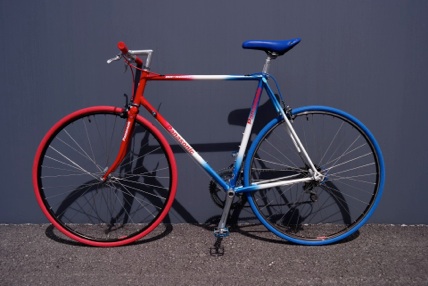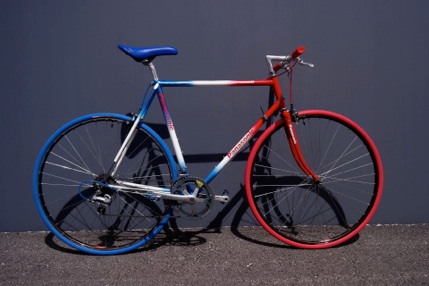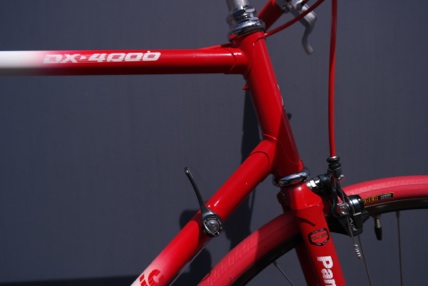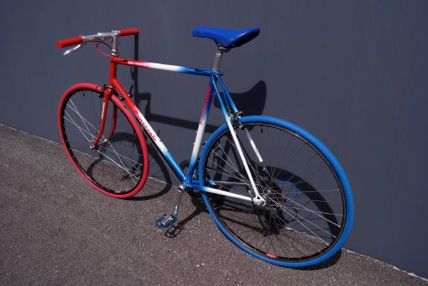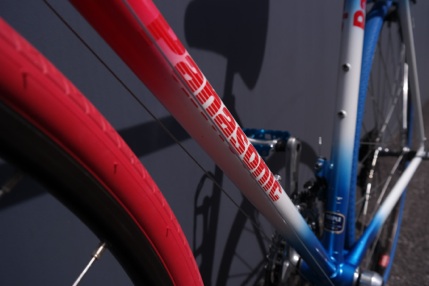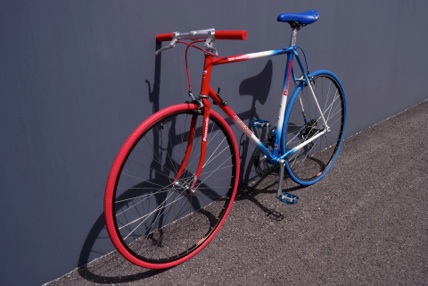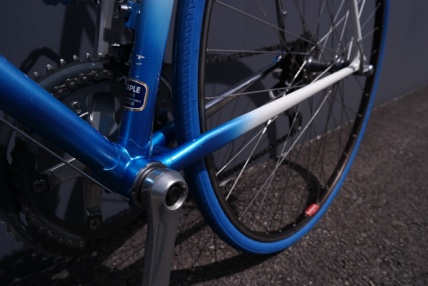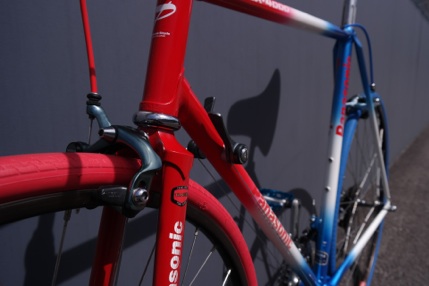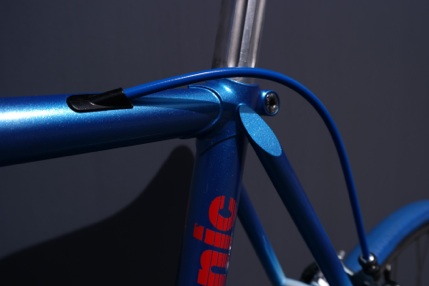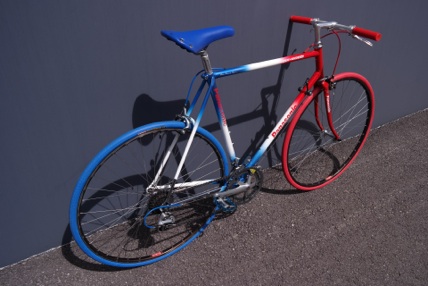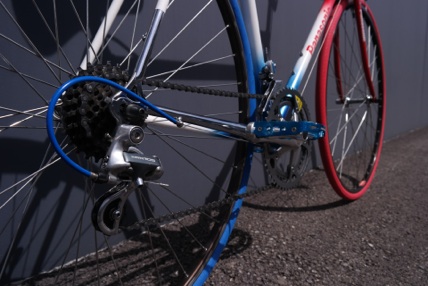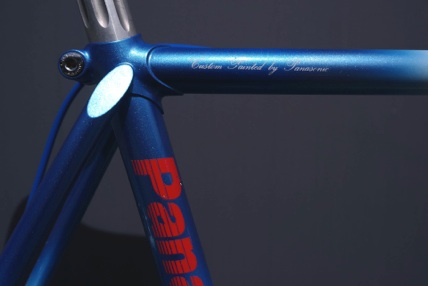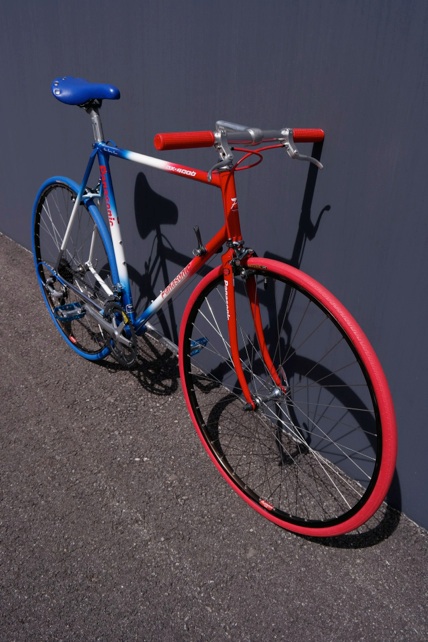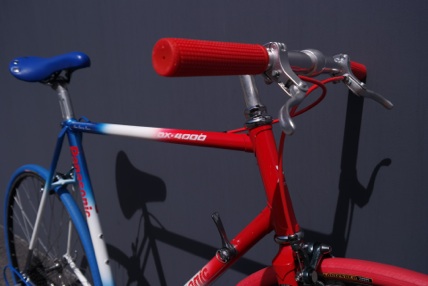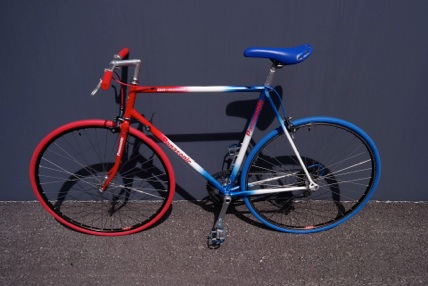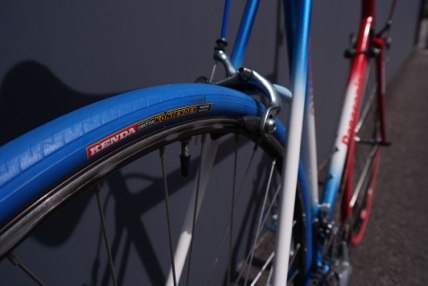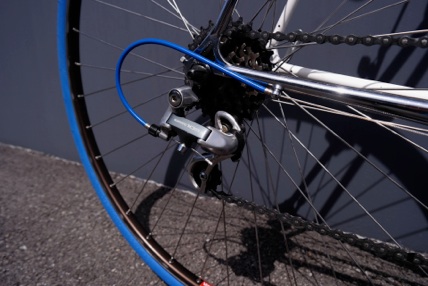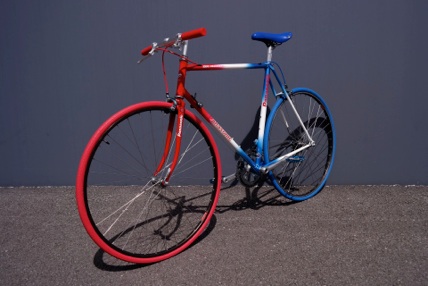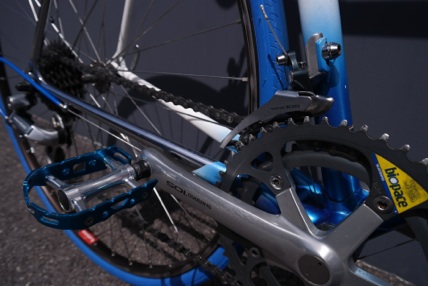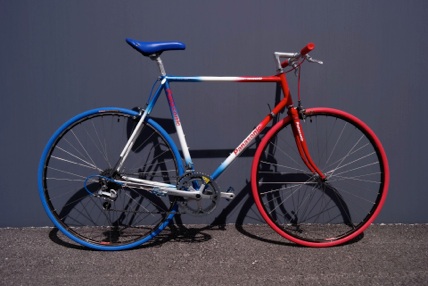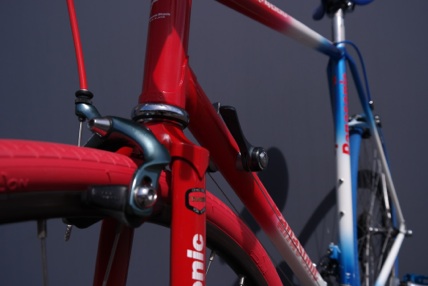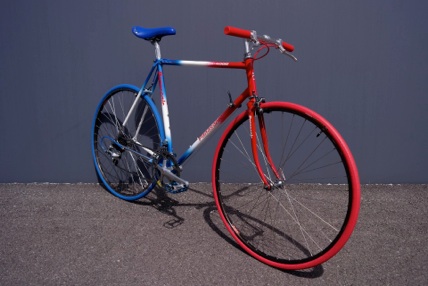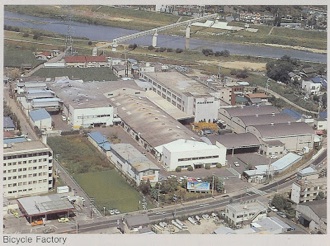Marke:
Typ:
Nickname:
Code:
Farbe:
Jahrgang:
Masse:
Rahmen:
Gabel:
Rahmen-Nr.:
Bremsen:
Bremshebel:
Schalthebel:
Schaltwerk:
Umwerfer:
Lenker:
Lenkergriffe:
Kurbel:
Pedale:
Reifen:
Felgen:
Nabe:
Sattel:
Beschrieb:
Racer: Panasonic DX-4000, rot-weiss-blau

Panasonic
Panasonic DX-4000 Renner, gerader Lenker, 14-Gang
„Super Victor“
trds116: t.rides.panasonic.86.05.2016
rot, weiss, blau
1986
580 mm (Sattelrohr, Mitte Tretlager bis OK Sattelrohr)
570 mm (Oberrohr, Mitte Sattelrohr bis Mitte Steuerrohr)
Für Körpergrössen von 175 - 185 cm geeignet
Tange Triple Cr-Mo triple butted, Stahlrahmen gemufft
Tange Cr-Mo Steel, Fork Blades
9000418
Shimano 105
Promax Retro B-Lever, 22.2 mm, silber (neu)
Shimano 105
Shimano 105
Shimano 105
Gerader Lenker BT-Swiss Alu matt, 46cm breit (neu)
Klean - Keirin, Soft Rubber, 115mm, rot (neu)
Shimano 105
XLC Ultralight PD-M15, rot (neu)
HR: Kenda Kontender Comp (700 x 26C), blau (neu)
VR: Kenda Kontender Comp (700 x 26C), rot (neu)
Araya 700c, bruniert
Shimano 105
Ventura Bike mit Chromnieten, Kunstleder blau (neu)
Rechtzeitig auf die Euro 2016 in Frankreich kommt
„Super Victor“, ein Offensivspieler mit Vorwärtsdrang aus
den Katakomben des „t.rides-Stadions“ ins Rampenlicht.
Wegen seiner Abschlussstärke wurde er kurzfristig aber
unumstritten für die nationale Auswahl nachnominiert.
„Super Victor“ zeichnet sich durch Geschmeidigkeit,
Athletik und einem guten Auge für Lücken in den
gegnerischen Verteidigung aus. Eine kaum sichtbare
kleine Delle am Oberrohr und minimale Kratzer am Lack
erinnern an vergangene Zweikämpfe. Nachvollziehbar,
dass ihn die gegnerischen Verteidiger reihenweise nur
mit unfairen Mitteln stoppen können.
Mit seinen 30 Jahren hat dieser Panasonic-Renner den
Zenith seiner Karriere noch nicht erreicht.
Eine Generalüberholung, Frischzellenkur und Wellness in
den Berner Alpen haben ihm offensichtlich neue
Lebensenergie eingeflöst und ihn besser den je werden
lassen.
Wird „Super Victor“ zur unvergesslichen Erinnerung an
die EURO 2016, wie es in seinem Geburtsjahr vor 30
Jahren eine Legende namens Diego Armando Maradona bei der WM in Mexiko wurde?
VERKAUFT,
ins Kirchenfeld.
Weitere Fotos und Informationen sind auf Wunsch
jederzeit erhältlich.
Herleitung des Übernamens: „Super Victor“
Super Victor, das offizielle Maskottchen für die UEFA EURO 2016 wurde am 18. November 2014 vor dem Länderspiel Frankreich gegen Schweden vorgestellt.
Zunächst hatte es keinen Namen, die Entscheidung fiel durch eine öffentliche Abstimmung. Insgesamt 107 790 Menschen haben sich daran beteiligt, mit 48 Prozent setzte sich letztendlich Super Victor durch, vor den anderen Vorschlägen Driblou (25 Prozent) und Goalix (27 Prozent).
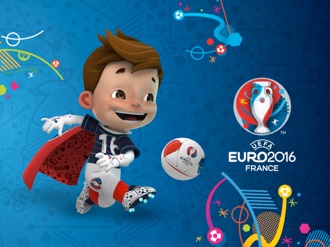
Wer bin ich?
Ich bin ein ganz normaler Junge, wie so viele andere! Ich wurde in einer kleinen Stadt in Frankreich geboren. Mein Vater war ein guter Fußballer und ich habe schon von klein auf gerne mit meinen Freunden Fußball gespielt. Ich bin nicht so gut wie mein Vater, aber ich versuche mich ständig zu verbessern. Aber das Wichtigste ist Spaß zu haben und fair zu bleiben!
Wie wurde ich zum Superhelden?
Eines Tages schoss ich bei einem Spiel mit meinen Freunden den Ball weit am Tor vorbei. Als ich ihn holen wollte, entdeckte ich eine Kiste. In dieser Kiste fand ich drei tolle Dinge: einen roten Umhang, tolle neue Fußballschuhe und den offiziellen Ball der UEFA EURO 2016! Auf einmal hörte ich ein merkwürdiges Geräusch und alles drehte sich um mich. Plötzlich merkte ich, dass viele unglaublich coole Dinge tun konnte!
Welche Superkräfte habe ich?
Mein toller roter Umhang macht es mir möglich, zu fliegen und die Welt superschnell zu umrunden! Das ist fantastisch, weil ich jetzt an einem Tag mit verschiedenen Leuten in ganz Frankreich Fußball spielen kann!
Meine magischen Fußballschuhe haben mir grandiose Fähigkeiten gegeben, ich kann sogar ganz neue Tricks erfinden! Ich liebe es, Leute zum Fußballspielen zusammenzubringen. Der Ball der UEFA EURO 2016 animiert alle zum kicken! Das ist meine magische Kraft, wir haben immer Spaß, wenn wir zusammen spielen.
Was ist meine Mission?
Als offizielles Maskottchen der UEFA EURO 2016 ist es meine Aufgabe, mit den Fans aus aller Welt Spaß zu haben und die Kunst des Fußballs zu feiern. Ich kann mich glücklich schätzen, solche Superkräfte zu haben, aber ich möchte dieses Geschenk gerne mit dem Rest der Welt teilen! Deshalb werde ich durch ganz Frankreich und um die ganze Welt reisen, um allen Menschen in allen Ländern Spaß und Glück zu bringen.
Zusatzinformationen zu diesem Objekt:
The History of Panasonic Bicycles
Mr. Konosuke Matsushita was the man behind the National/Panasonic company. As a child he was adopted into a family who owned a bicycle shop. He passion for bicycles began at an early age and before long he was creating new innovations for the benefit of the cycling world.
In Japan, Mr. Matsushita’s company was known as National. This presented problems when looking to sell products in other countries such as the USA, so the name Panasonic came about for use on exported products.
Mr. Matsushita was always passionate about his bicycles and he refused to put his name on something he considered to be less than a quality product. Perhaps this would explain why even the inexpensive low-end models such as the Sport 500 seemed to be so much nicer than the boat anchor department store bikes being sold at the time.
Matsushita was also known for his Panaracer brand bicycle tires. He created the first successful synthetic tubular tires and Panasonic tubular cement is also highly regarded.
Panasonic Historical Timeline
-
•1918 – Mashushita Electric founded. (Parent company that would eventually be known as Panasonic)
-
•1923 – A new battery powered bicycle headlamp was developed and distributed to bicycle dealers.
-
•1951 – Bicycle frame production begins
-
•1952 – Production of a roadster-model bicycle by C.K.D.
-
•National Tire Company established
-
•1956 – Sport type bicycle production begins
-
•1958 – Received license of sticking certification mark of J.I.S. (Japan Industrial Standard) for frames from M.I.T.I. (Ministry of International Trade and Industry)
-
•1962 – Received license of sticking certification mark of J.I.S. for complete bicycles from M.I.T.I.
-
•1965 – Factory established in Kashihara city in Osaka, Japan and National Bicycle Ind. Co. was established
-
•1967 – Japanese national bicycle racing team adopts use of our bicycles for World champion competition.
-
•1971 – Began to export Panasonic bicycles to Panasonic Company U.S.A. Also began to export bicycles to Schwinn Bicycle Company U.S.A.
-
•1972 – Japanese Olympic Bicycle Team adopted our racing bicycles for Munich Olympics.
-
•1973 – Reward received for quality control from Osaka division of M.I.T.I.
-
•1974 – Gojyo National Bicycle Parts Co. Ltd. established (wheel assembly factory)
-
•1976 – Japenese Olympic Bicycle Team adopted our bicycles for the Montreal Olympics. Only our Racing and 10 Speed bicycles were selected as up-to-date bicycles among the world bicycling manufacturers and demostrated at Benjamin Franklin Institute in Philadelphia for the American Bicentenial Celebration.
-
•1979 – Began to export frames and bicycles to Europe.
-
•Began to export frames and bicycles to Canada.
-
•Began to export frames and bicycles to Austrailia.
-
•Organized Panasonic/Shimano Racing Team in U.S.A.
-
•1980 – Began to export bicycles to T.I. Raleigh (U.S.A.)
-
•Japanese Olympic Bicycle Team adopted our racing bicycles for the 1980 Moscow Olympics
-
•1989 – Panasonic Bicycles pulls out of North American market after the Dollar/Yen ratio makes bicycle market too unprofitable.
-
•TODAY – Panasonic continues to build high quality bicycles for other world markets. A small number of bikes and frames remain available to North America through Madison, Wisconsin based Yellow Jersey Bicycles.
Panasonic in North America
Panasonic began exporting bikes to the U.S. way back in 1971. Those were the early bicycle boom days and Panasonic having been a bicycle maker for many years wanted in on the market.
We were lucky enough to be put in touch with the ex National Sales Manager for Panasonic’s bicycle division here in the U.S., Mr. Norman Halperin. Panasonic was Norman’s initial entry into the bicycle industry – starting with Panasonic on April 19th, 1979 as a Sales Rep covering Metro New York, New Jersey and Connecticut. At the time Panasonic had only one other Rep in the Chicago area and after another six months he left the company.
With only six months experience in the bike business Norman found himself being a senior man in sales department. It was at that point that Panasonic decided to go nationwide and Norman became the National Sales Manager and started hiring reps all over the country.
Panasonic bikes hiding behind other labels…
You may be surprised to learn that Schwinn, Raleigh, Royce Union, Suteki, Centurion and other labels all at one time or another had Panasonic built bicycles wearing their badges. Schwinn’s very first outsourced bikes back in the early 70s were built by Panasonic. These were the “World” bikes such as the World Traveller and World Voyager. Later on in the 70s, Schwinn made a deal with Panasonic to build the LeTour model which would become the second most popular model for Schwinn in the 1970s
Fotos und Infos vom Original Panasonic DX-3000:
www.panasonicbikemuseum.info/1986-panasonic-dx-3000/
